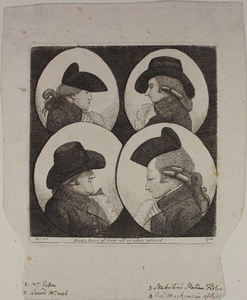| Method | Etching and stipple |
| Artist | John Kay |
| Published | [John Kay, 1786] |
| Dimensions | Image 110 x 104 mm, Plate 112 x 106 mm, Sheet 169 x 137 mm |
| Notes |
Four oval portraits arranged in facing pairs on a shaded background. All of the men are wearing dark cocked hats, dark jackets, and ruffed collars. Top left is Eiston and facing him is Hieronymo Stablini. Bottom left is Laird Francis McNab and facing him is Captain McKenzie. (Bucks have at you all or who's afraid) and Kay Fecit 1786 inscribed under the image. Lifetime impression. Dr. Eiston (active 1786) was a well-known macaroni at Edinburgh University, and later an assistant surgeon in the army. (Girolamo) Hieronymo Stabilini (1762-1815) was an Edinburgh musician, originally from Rome. Francis Macnab (1734-1816) was 16th Chief of the Clan Macnab. Captain McKenzie of Redcastle (active 1786) was an officer in Seaforth's regiment of Highlanders. McKenzie was found guilty of murder for ordering, when in command of a small post in Africa (1782), a mutinous deserter to be blown from the muzzle of a gun, but was pardoned. John Kay (1742-1826) was a Scottish miniature painter, satirist, and engraver, chiefly celebrated for his caricatures of many of the most notable Scotsmen of his day. Born in Dalkieth, the son of a Mason, he was orphaned at a young age, and following an unhappy childhood with his mother's relatives in Leith, he was apprenticed to the barber, George Heriot. After six years working under Heriot in Dalkieth, he moved as a journeyman barber to Edinburgh. In 1771, he joined the Corporation of Barber Surgeons, gained the freedom of the city, and set up his own barbershop. Despite having no formal training in, and no great talent for, the finer points of artistic pursuits, he pursued his drawing with dedication. Kay's quick hand and canny wit made him a natural satirist, and the remarkable likenesses of his earlier portraits to their real world counterparts began to be noticed by his customers. The most important of these was William Nisbet of Dirleton, who would eventually become his patron. Nisbet's death in 1784 brought Kay a small annuity, which enabled him to give up his barbershop, and focus his full attentions on his art. From a small shop in Parliament Close, Edinburgh, Kay issued his portraits. Redgrave attributes to Kay almost nine hundred plates, which constitute an unparalleled chronicle of Edinburgh life at the turn of the eighteenth and nineteenth centuries. Kay's portraits, though objectively of only slim artistic merit, are warm, lively, and in some cases, bitingly clever. His talent for provoking his subjects was famous, leading on one occasion to a failed prosecution, and on another to an apparent cudgeling. Despite this, Kay's star continued to rise. In 1811 and 1816, his work was exhibited by the Edinburgh Associated Artists, and in 1822, he contributed to the Institution for the Encouragement of the Fine Arts in Scotland. As early as 1792, he had planned to release a collection of his works in book form, along with a short biographical sketch that supplies almost all of the known details of his life, but the project remained unrealized at his death. It was not until 1837, almost a decade after his death, that a collection of 340 of his plates were first published. BM Satires 7026 Ex. Col.: Hon. Christopher Lennox-Boyd Condition: Light foxing to sheet, tipped to an album page, margins trimmed lower left and right, manuscript inscription in a contemporary hand in ink along bottom margin, otherwise an excellent impression on laid paper. |
| Framing | unmounted |
| Price | £85.00 |
| Stock ID | 42386 |

